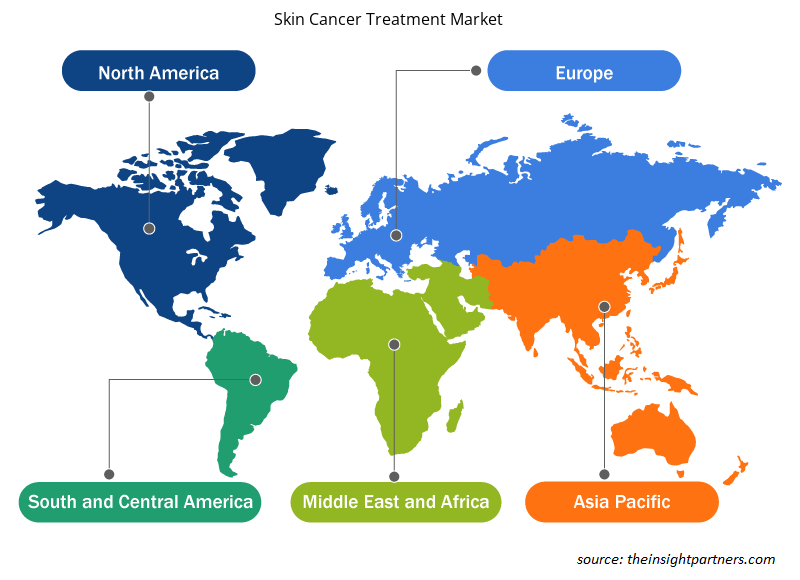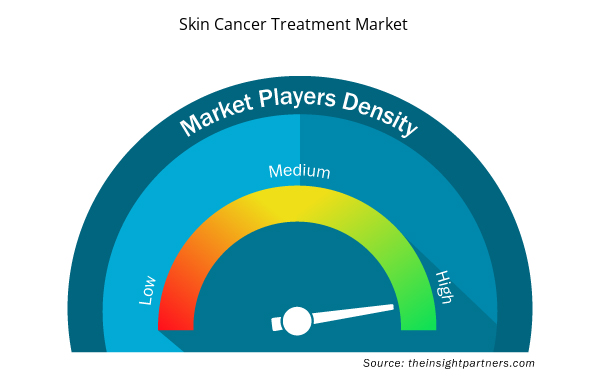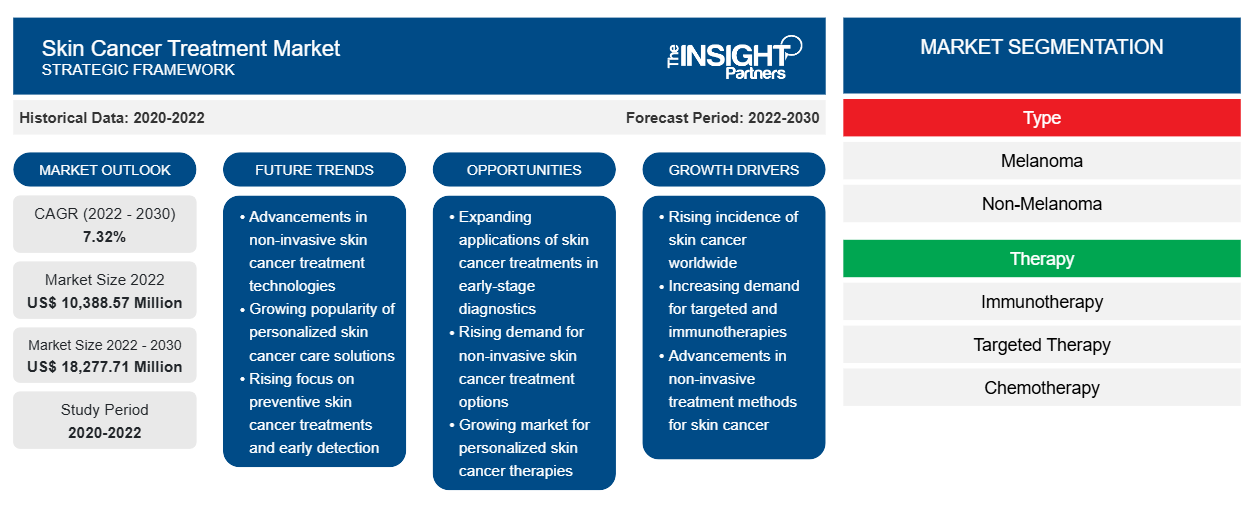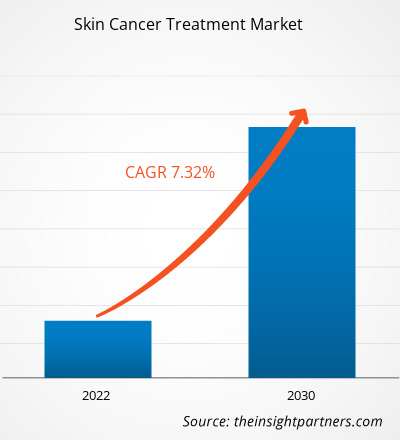[تقرير بحثي] من المتوقع أن ينمو حجم سوق علاج سرطان الجلد من 10،388.57 مليون دولار أمريكي في عام 2022 إلى 18،277.71 مليون دولار أمريكي بحلول عام 2030؛ ومن المتوقع أن يسجل السوق معدل نمو سنوي مركب بنسبة 7.32٪ من عام 2022 إلى عام 2030.
رؤى السوق ووجهة نظر المحلل:
يمكن أن تساعد توقعات سوق علاج سرطان الجلد أصحاب المصلحة في هذا السوق في التخطيط لاستراتيجيات نموهم. الورم الميلانيني وغير الميلانيني من أنواع سرطان الجلد. يمكن أن يؤدي التعرض المفرط لأشعة الشمس إلى الإصابة بسرطان الجلد. وفقًا لجمعية الأكاديمية الأمريكية للأمراض الجلدية، يصيب سرطان الجلد واحدًا من كل خمسة أمريكيين. علاوة على ذلك، وفقًا للمجموعة، يتلقى ما يقرب من 3 ملايين أمريكي تشخيصًا بسرطان الجلد غير الميلانيني سنويًا. يؤدي الانتشار المتزايد لسرطان الجلد الميلانيني وغير الميلانيني إلى زيادة إيرادات السوق.
العلاج المناعي والعلاج الموجه والعلاج الكيميائي والعلاج الإشعاعي من بين العلاجات المتاحة لسرطان الجلد. علاوة على ذلك، يتم استخدام كريم 5-فلورويوراسيل، المصنف كشكل من أشكال العلاج الكيميائي، في هذا العلاج. ومع ذلك، نظرًا لأن الجراحة هي علاج أكثر فعالية لسرطان الجلد، فهي الخيار المفضل. علاوة على ذلك، تتضمن اتجاهات سوق علاج سرطان الجلد زيادة الأدوية المتاحة.
محركات النمو والتحديات:
إن الانتشار المتزايد للورم الميلانيني وغير الميلانيني يدفع حجم سوق علاج سرطان الجلد. وقد برز الانتشار المتزايد للورم الميلانيني وغير الميلانيني كمحرك مهم يدفع نمو وتنويع السوق. زاد عدد الأدوية المستخدمة لعلاج سرطان الجلد مؤخرًا نتيجة للانتشار المتزايد للمرض وزيادة الوعي العام. وفقًا لأحدث البيانات الصادرة عن المكتبة الوطنية للطب في عام 2022، تسجل الولايات المتحدة 1.8 مليون حالة سرطان الخلايا الحرشفية ( SCC ) و 3.6 مليون حالة سرطان الخلايا القاعدية ( BCC ) سنويًا. إن ارتفاع معدل الإصابة بسرطان الجلد يدفع الطلب على علاجات سرطان الجلد.
لقد زاد تعرض الناس للأشعة فوق البنفسجية في السنوات الأخيرة بسبب تسارع ظاهرة الاحتباس الحراري العالمي. كما زاد عدد حالات سرطان الجلد بين السكان في المناطق التي يكون فيها استنفاد الأوزون أكثر حدة. وأفاد مجلس السرطان في أستراليا أن سرطان الجلد الناجم عن التعرض لأشعة الشمس يمثل أكثر من 80% من جميع حالات السرطان المبلغ عنها في البلاد كل عام. وتضيف المجموعة أن الولايات المتحدة والمملكة المتحدة وكندا لديها أعلى معدلات الإصابة بسرطان الجلد. بالإضافة إلى ذلك، فإن كبار السن معرضون بشكل خاص للإصابة بسرطان الجلد. ومن المتوقع أن يدعم ارتفاع عدد كبار السن في هذه المناطق توسع السوق.
يواجه سوق علاج سرطان الجلد تحديًا كبيرًا بسبب الآثار السلبية لوسائل العلاج الحالية، والتي تؤثر على نمو السوق. يمكن أن تؤدي خيارات العلاج التقليدية مثل الجراحة والعلاج الكيميائي والعلاج الإشعاعي والعلاج المناعي إلى آثار ضارة، بما في ذلك تهيج الجلد والسموم الجهازية والمضاعفات طويلة الأمد وغيرها. يمكن أن تؤثر الآثار الجانبية بشكل كبير على جودة حياة المرضى وقد تردع بعض الأفراد عن طلب العلاج أو الالتزام به. علاوة على ذلك، قد تؤدي قيود خيارات العلاج الحالية إلى الحاجة إلى استكشاف علاجات بديلة وأقل تدخلاً وأكثر استهدافًا لسرطان الجلد. مع تركيز أنشطة البحث والتطوير على تطوير وسائل العلاج مع تحسين ملفات تعريف السلامة والفعالية، فإن السوق على استعداد لمشاهدة ابتكارات تحويلية تعالج هذه التحديات، وتقدم أملًا جديدًا للمرضى وتدفع توسع السوق.ومن ثم، فإن الآثار السلبية لوسائل العلاج الحالية تعيق نمو سوق علاج سرطان الجلد.
قم بتخصيص هذا التقرير ليناسب متطلباتك
ستحصل على تخصيص لأي تقرير - مجانًا - بما في ذلك أجزاء من هذا التقرير، أو تحليل على مستوى الدولة، وحزمة بيانات Excel، بالإضافة إلى الاستفادة من العروض والخصومات الرائعة للشركات الناشئة والجامعات
- احصل على أهم اتجاهات السوق الرئيسية لهذا التقرير.ستتضمن هذه العينة المجانية تحليلاً للبيانات، بدءًا من اتجاهات السوق وحتى التقديرات والتوقعات.
تقسيم التقرير ونطاقه:
تم إجراء "تحليل سوق علاج سرطان الجلد" من خلال النظر في ما يليالقطاعات: على أساس النوع والعلاج والمستخدم النهائي. بناءً على النوع، ينقسم السوق إلى سرطان الجلد وغير الميلانيني. يتم تقسيم سوق علاج سرطان الجلد، حسب العلاج، إلى العلاج المناعي والعلاج الموجه والعلاج الكيميائي والعلاج الإشعاعي وغيرها. حسب المستخدم النهائي، يتم تقسيم السوق إلى المستشفيات وعيادات الأمراض الجلدية ومراكز التشخيص وغيرها. من حيث الجغرافيا، يتم تقسيم تقرير سوق علاج سرطان الجلد إلى أمريكا الشمالية (الولايات المتحدة وكندا والمكسيك) وأوروبا (المملكة المتحدة وألمانيا وفرنسا وإيطاليا وإسبانيا وبقية أوروبا) وآسيا والمحيط الهادئ (الصين واليابان والهند وأستراليا وكوريا الجنوبية وبقية آسيا والمحيط الهادئ) والشرق الأوسط وأفريقيا (الإمارات العربية المتحدة والمملكة العربية السعودية وجنوب إفريقيا وبقية الشرق الأوسط وأفريقيا) وأمريكا الجنوبية والوسطى (البرازيل والأرجنتين وبقية أمريكا الجنوبية والوسطى).
التحليل القطاعي:
بناءً على النوع، ينقسم سوق علاج سرطان الجلد إلى سرطان الجلد الميلانيني وغير الميلانيني. ومن المتوقع أن يحتفظ قطاع سرطان الجلد الميلانيني بحصة سوقية أكبر خلال فترة التنبؤ. تنقسم الخلايا الصبغية على الجلد بشكل غير طبيعي، والمعروف باسم سرطان الجلد الميلانيني. ويعزز ارتفاع معدل الإصابة بسرطان الجلد الميلانيني في العديد من الدول الآسيوية والأوروبية نمو سوق هذا القطاع. وتعد الجراحة والعلاج الإشعاعي من العلاجات الرئيسية لسرطان الجلد غير الميلانيني. ومع ذلك، من المتوقع أن يدعم إطلاق أدوية العلاج المناعي لعلاج سرطان الجلد بخلاف سرطان الجلد الميلانيني توسع سوق هذا القطاع في السنوات القادمة. ومن المتوقع أن ينمو السوق في السنوات القادمة مع توفر الأدوية العلاجية لعلاج غير الميلانوما على نطاق واسع.
بناءً على العلاج، يتم تقسيم سوق علاج سرطان الجلد إلى العلاج المناعي والعلاج الموجه والعلاج الكيميائي والعلاج الإشعاعي وغيرها. نظرًا للآثار الضارة للإشعاع والعلاج الكيميائي، يتم استخدام أدوية العلاج المناعي بشكل متكرر لعلاج سرطان الجلد. علاوة على ذلك، تعمل خيارات العلاج، مثل العلاج الموجه، على تحسين نجاح علاج سرطان الجلد. عندما يتقدم سرطان الجلد إلى النقطة التي تصبح فيها خيارات العلاج الأخرى غير عملية، يقترح الأطباء العلاج المناعي والعلاج الموجه. ومن المتوقع أن تعزز هذه العوامل نمو سوق علاج سرطان الجلد للعلاج الموجه والعلاج المناعيمن المتوقع أن تشهد قطاعات العلاج المستهدفة نموًا متزايدًا في السنوات القادمة. علاوة على ذلك، من المتوقع أن تحظى قطاعات العلاج المستهدفة بحصة كبيرة في سوق علاج سرطان الجلد بحلول عام 2030.
التحليل الإقليمي:
على أساس المنطقة، يتم تقسيم سوق علاج سرطان الجلد إلى أمريكا الشمالية وأوروبا ومنطقة آسيا والمحيط الهادئ والشرق الأوسط وأفريقيا وأمريكا الجنوبية والوسطى.
تُعَد أمريكا الشمالية المساهم الأكبر في نمو سوق علاج سرطان الجلد نظرًا لارتفاع معدل الإصابة بسرطان الجلد في الولايات المتحدة وزيادة استخدام أدوية السرطان في تلك الدولة. بالإضافة إلى ذلك، من المتوقع أن يكون لميل المشاركين الرئيسيين في الصناعة إلى تقديم علاجات جديدة لسرطان الجلد تأثير إيجابي على توسع السوق في المنطقة. نظرًا لأن سرطان الجلد غير الميلانيني أكثر شيوعًا في السكان القوقازيين، فإن أمريكا الشمالية وأوروبا تمثلان جزءًا كبيرًا من السوق العالمية.
من المتوقع أن ينمو حجم سوق علاج سرطان الجلد في منطقة آسيا والمحيط الهادئ بأعلى معدل خلال الفترة المتوقعة بسبب انتشار الورم الميلانيني وغير الميلانيني في دول مثل أستراليا ونيوزيلندا. في منطقة آسيا والمحيط الهادئ، يدعم الجمع بين الموافقات التنظيمية لأدوية سرطان الجلد والسوق الكبيرة وغير المتطورة في البلدان النامية توسع سوق علاج سرطان الجلد في المنطقة. مع ارتفاع حالات الورم الميلانيني في أوروبا، من المتوقع أن تتطور إيرادات السوق بشكل صحي خلال الفترة المتوقعة.
رؤى إقليمية حول سوق علاج سرطان الجلد
لقد قام المحللون في Insight Partners بشرح الاتجاهات والعوامل الإقليمية المؤثرة على سوق علاج سرطان الجلد طوال فترة التوقعات بشكل شامل. يناقش هذا القسم أيضًا قطاعات سوق علاج سرطان الجلد والجغرافيا في جميع أنحاء أمريكا الشمالية وأوروبا ومنطقة آسيا والمحيط الهادئ والشرق الأوسط وأفريقيا وأمريكا الجنوبية والوسطى.

- احصل على البيانات الإقليمية المحددة لسوق علاج سرطان الجلد
نطاق تقرير سوق علاج سرطان الجلد
| سمة التقرير | تفاصيل |
|---|---|
| حجم السوق في عام 2022 | 10,388.57 مليون دولار أمريكي |
| حجم السوق بحلول عام 2030 | 18,277.71 مليون دولار أمريكي |
| معدل النمو السنوي المركب العالمي (2022 - 2030) | 7.32% |
| البيانات التاريخية | 2020-2022 |
| فترة التنبؤ | 2022-2030 |
| القطاعات المغطاة | حسب النوع
|
| المناطق والدول المغطاة | أمريكا الشمالية
|
| قادة السوق وملفات تعريف الشركات الرئيسية |
|
كثافة اللاعبين في سوق علاج سرطان الجلد: فهم تأثيرها على ديناميكيات الأعمال
يشهد سوق علاج سرطان الجلد نموًا سريعًا، مدفوعًا بالطلب المتزايد من المستخدم النهائي بسبب عوامل مثل تفضيلات المستهلكين المتطورة والتقدم التكنولوجي والوعي المتزايد بفوائد المنتج. ومع ارتفاع الطلب، تعمل الشركات على توسيع عروضها والابتكار لتلبية احتياجات المستهلكين والاستفادة من الاتجاهات الناشئة، مما يؤدي إلى زيادة نمو السوق.
تشير كثافة اللاعبين في السوق إلى توزيع الشركات أو المؤسسات العاملة في سوق أو صناعة معينة. وهي تشير إلى عدد المنافسين (اللاعبين في السوق) الموجودين في مساحة سوق معينة نسبة إلى حجمها أو قيمتها السوقية الإجمالية.
الشركات الرئيسية العاملة في سوق علاج سرطان الجلد هي:
- إليكتا
- شركة نوفارتيس ايه جي
- شركة ف. هوفمان لاروش المحدودة
- ديرماكيور-آر تي
- Xoft (iCAD، Inc.)
إخلاء المسؤولية : الشركات المذكورة أعلاه ليست مرتبة بأي ترتيب معين.

- احصل على نظرة عامة على أهم اللاعبين الرئيسيين في سوق علاج سرطان الجلد
تطورات الصناعة والفرص المستقبلية:
فيما يلي قائمة ببعض المبادرات التي اتخذها اللاعبون الرئيسيون العاملون في سوق علاج سرطان الجلد العالمي:
- في أكتوبر 2023، أعلنت شركة بريستول مايرز سكويب، بموافقة إدارة الغذاء والدواء الأمريكية على عقار أوبديفو (نيفولوماب)، أنها تستطيع الآن علاج المرضى البالغين والأطفال الذين تبلغ أعمارهم 12 عامًا أو أكثر والذين يعانون من ورم خبيث في المرحلة الثانية ب أو المرحلة الثانية ج تم استئصاله بالكامل كعلاج مساعد. وهذا يوسع نطاق عقار أوبديفو الحالي ويعزز إرث الشركة في تقديم خيارات علاجية لمرضى الورم الخبيث. كانت تجربة CheckMate -76K من المرحلة 3، والتي قارنت بين عقار أوبديفو (ن = 526) ودواء وهمي (ن = 264)، بمثابة الأساس للموافقة.
- في مارس 2023، وافقت إدارة الغذاء والدواء الأمريكية (FDA) على استخدام Zynyz، وهو جسم مضاد وحيد النسيلة يستهدف مستقبلات الموت المبرمج 1 (PD-1) لعلاج البالغين المصابين بسرطان الخلايا الميركلية المتقدم المحلي المتكرر أو النقيلي. بناءً على معدل استجابة الورم ومدة الاستجابة (DOR)، وافقت إدارة الغذاء والدواء الأمريكية على Zynyz بموجب الموافقة المعجلة؛ ومع ذلك، قد يخضع استمرار موافقة Zynyz على هذا المؤشر للتحقق ووصف الفائدة السريرية في التجارب التأكيدية.
المنافسة والشركات الرئيسية:
تعد Merck & Co. وBristol Mayers Squibb وNovartis AG وRoche وAmgen Inc. وGSK وPfizer Inc. وSun Pharmaceutical وRegeneron Pharmaceuticals من بين الشركات الرئيسية العاملة في تقرير سوق علاج سرطان الجلد. تركز هذه الشركات على توسيع عروضها لتلبية الطلب المتزايد من المستهلكين في جميع أنحاء العالم. يسمح لها وجودها العالمي بخدمة العديد من العملاء، مما يسمح لها بتوسيع حصتها في السوق.
- التحليل التاريخي (سنتان)، السنة الأساسية، التوقعات (7 سنوات) مع معدل النمو السنوي المركب
- تحليل PEST و SWOT
- حجم السوق والقيمة / الحجم - عالميًا وإقليميًا وقطريًا
- الصناعة والمنافسة
- مجموعة بيانات Excel



Report Coverage
Revenue forecast, Company Analysis, Industry landscape, Growth factors, and Trends

Segment Covered
This text is related
to segments covered.

Regional Scope
North America, Europe, Asia Pacific, Middle East & Africa, South & Central America

Country Scope
This text is related
to country scope.
الأسئلة الشائعة
The light therapy market was valued at US$ 10,388.57 million in 2022.
The light therapy market has major market players, including Merck & Co., Bristol Mayers Squibb, Novartis AG, Roche, Amgen Inc., GSK, Pfizer Inc., Sun Pharmaceutical, and Regeneron Pharmaceuticals.
Melanoma and non-melanoma are skin cancer types. Excessive sunlight exposure can cause skin cancer. As per the American Academy of Dermatology Association, skin cancer affects one in five Americans. Furthermore, according to the group, almost 3 million Americans receive a diagnosis of non-melanoma skin cancer annually. Growing prevalence of melanoma and non-melanoma skin cancer drives the market revenue.
Based on therapy, the skin cancer treatment market is segmented into immunotherapy, targeted therapy, chemotherapy, radiation therapy, and others. Considering the adverse effects of radiation and chemotherapy, immunotherapy medications are being utilized more often to treat skin cancer. Furthermore, treatment options, such as targeted therapy, improve skin cancer treatment success. When skin cancer has advanced to the point where other treatment options are not practical, physicians propose immunotherapy and targeted therapy. It is expected that these factors will boost the skin cancer treatment market growth for the targeted therapy and immunotherapy segments in the coming years.
The light therapy market is expected to be valued at US$ 18,277.71 million in 2030.
Based on type, the skin cancer treatment market is bifurcated into melanoma and non-melanoma. The melanoma segment is expected to hold a larger market share during the forecast period. Melanocytes on the skin divide abnormally, known as melanoma skin cancer. Rising incidence of melanoma in several Asian and European countries bolsters the market growth for the segment. Surgery and radiation therapy are main treatments for non-melanoma skin cancer. Nonetheless, the launch of immunotherapy medications to treat skin cancer other than melanoma is anticipated to support the market expansion for the segment in the next years. The market is expected to grow in the coming years as therapeutic medications for non-melanoma treatment become widely available..
The increasing prevalence of melanoma and non-melanoma has emerged as a significant driver propelling the growth and diversification of the skin cancer treatment market. The number of medications used to treat skin cancer has increased recently as a result of the growing prevalence of the disease and rising public awareness.
Trends and growth analysis reports related to Life Sciences : READ MORE..
The List of Companies - Skin Cancer Treatment Market
- Elekta
- Novartis AG
- F.Hoffmann La-Roche Ltd.
- Dermacure-rt
- Xoft (iCAD, Inc.)
- Merck KGaA
- GalaxoSmithKline plc.
- Amgen, Inc.
- Eli Lily and Company
- Sun PharmaceuticalsMerck & Co.
The Insight Partners performs research in 4 major stages: Data Collection & Secondary Research, Primary Research, Data Analysis and Data Triangulation & Final Review.
- Data Collection and Secondary Research:
As a market research and consulting firm operating from a decade, we have published and advised several client across the globe. First step for any study will start with an assessment of currently available data and insights from existing reports. Further, historical and current market information is collected from Investor Presentations, Annual Reports, SEC Filings, etc., and other information related to company’s performance and market positioning are gathered from Paid Databases (Factiva, Hoovers, and Reuters) and various other publications available in public domain.
Several associations trade associates, technical forums, institutes, societies and organization are accessed to gain technical as well as market related insights through their publications such as research papers, blogs and press releases related to the studies are referred to get cues about the market. Further, white papers, journals, magazines, and other news articles published in last 3 years are scrutinized and analyzed to understand the current market trends.
- Primary Research:
The primarily interview analysis comprise of data obtained from industry participants interview and answers to survey questions gathered by in-house primary team.
For primary research, interviews are conducted with industry experts/CEOs/Marketing Managers/VPs/Subject Matter Experts from both demand and supply side to get a 360-degree view of the market. The primary team conducts several interviews based on the complexity of the markets to understand the various market trends and dynamics which makes research more credible and precise.
A typical research interview fulfils the following functions:
- Provides first-hand information on the market size, market trends, growth trends, competitive landscape, and outlook
- Validates and strengthens in-house secondary research findings
- Develops the analysis team’s expertise and market understanding
Primary research involves email interactions and telephone interviews for each market, category, segment, and sub-segment across geographies. The participants who typically take part in such a process include, but are not limited to:
- Industry participants: VPs, business development managers, market intelligence managers and national sales managers
- Outside experts: Valuation experts, research analysts and key opinion leaders specializing in the electronics and semiconductor industry.
Below is the breakup of our primary respondents by company, designation, and region:

Once we receive the confirmation from primary research sources or primary respondents, we finalize the base year market estimation and forecast the data as per the macroeconomic and microeconomic factors assessed during data collection.
- Data Analysis:
Once data is validated through both secondary as well as primary respondents, we finalize the market estimations by hypothesis formulation and factor analysis at regional and country level.
- Macro-Economic Factor Analysis:
We analyse macroeconomic indicators such the gross domestic product (GDP), increase in the demand for goods and services across industries, technological advancement, regional economic growth, governmental policies, the influence of COVID-19, PEST analysis, and other aspects. This analysis aids in setting benchmarks for various nations/regions and approximating market splits. Additionally, the general trend of the aforementioned components aid in determining the market's development possibilities.
- Country Level Data:
Various factors that are especially aligned to the country are taken into account to determine the market size for a certain area and country, including the presence of vendors, such as headquarters and offices, the country's GDP, demand patterns, and industry growth. To comprehend the market dynamics for the nation, a number of growth variables, inhibitors, application areas, and current market trends are researched. The aforementioned elements aid in determining the country's overall market's growth potential.
- Company Profile:
The “Table of Contents” is formulated by listing and analyzing more than 25 - 30 companies operating in the market ecosystem across geographies. However, we profile only 10 companies as a standard practice in our syndicate reports. These 10 companies comprise leading, emerging, and regional players. Nonetheless, our analysis is not restricted to the 10 listed companies, we also analyze other companies present in the market to develop a holistic view and understand the prevailing trends. The “Company Profiles” section in the report covers key facts, business description, products & services, financial information, SWOT analysis, and key developments. The financial information presented is extracted from the annual reports and official documents of the publicly listed companies. Upon collecting the information for the sections of respective companies, we verify them via various primary sources and then compile the data in respective company profiles. The company level information helps us in deriving the base number as well as in forecasting the market size.
- Developing Base Number:
Aggregation of sales statistics (2020-2022) and macro-economic factor, and other secondary and primary research insights are utilized to arrive at base number and related market shares for 2022. The data gaps are identified in this step and relevant market data is analyzed, collected from paid primary interviews or databases. On finalizing the base year market size, forecasts are developed on the basis of macro-economic, industry and market growth factors and company level analysis.
- Data Triangulation and Final Review:
The market findings and base year market size calculations are validated from supply as well as demand side. Demand side validations are based on macro-economic factor analysis and benchmarks for respective regions and countries. In case of supply side validations, revenues of major companies are estimated (in case not available) based on industry benchmark, approximate number of employees, product portfolio, and primary interviews revenues are gathered. Further revenue from target product/service segment is assessed to avoid overshooting of market statistics. In case of heavy deviations between supply and demand side values, all thes steps are repeated to achieve synchronization.
We follow an iterative model, wherein we share our research findings with Subject Matter Experts (SME’s) and Key Opinion Leaders (KOLs) until consensus view of the market is not formulated – this model negates any drastic deviation in the opinions of experts. Only validated and universally acceptable research findings are quoted in our reports.
We have important check points that we use to validate our research findings – which we call – data triangulation, where we validate the information, we generate from secondary sources with primary interviews and then we re-validate with our internal data bases and Subject matter experts. This comprehensive model enables us to deliver high quality, reliable data in shortest possible time.


 احصل على عينة مجانية لهذا التقرير
احصل على عينة مجانية لهذا التقرير